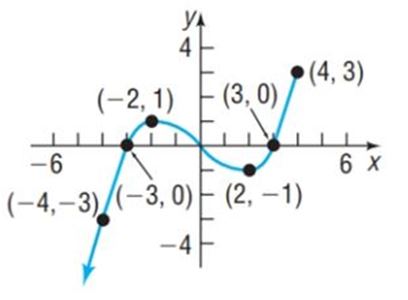
Concept explainers
Use the graph of the function shown to find:
(a) The domain and the range of .
(b) The intervals on which is increasing, decreasing, or constant.
(c) The
(d) The absolute maximum and absolute minimum.
(e) Whether the graph is symmetric with respect to the , the , or the origin.
(f) Whether the function is even, odd, or neither.
(g) The intercepts, if any.

To find:
a. The domain and the range of .
Answer to Problem 17RE
Solution:
a. .
Explanation of Solution
Given:

Calculation:
a. Domain: set of all the values of for which graph is defined.
Hence domain .
Range: set of all the values of for which graph is defined.
Hence Range .
To find:
b. The intervals on which is increasing, decreasing, or constant.
Answer to Problem 17RE
Solution:
b. The function is increasing in the interval .
The function is decreasing in the interval .
The function is not constant on any interval.
Explanation of Solution
Given:

Calculation:
b. From the graph we see that, the function is increasing in the interval and that is .
The function is decreasing in the interval .
The function is not constant on any interval.
To find:
c. The local minimum values and local maximum values.
Answer to Problem 17RE
Solution:
c. local maximum value is and . There is no Local minimum.
Explanation of Solution
Given:

Calculation:
c. Local maximum exists at and the local maximum value is .
Local maximum exists at and the local maximum value is .
The graph does not have local minimum.
To find:
d. The absolute maximum and absolute minimum.
Answer to Problem 17RE
Solution:
d. The graph has absolute maximum at and it does not have absolute minimum.
Explanation of Solution
Given:

Calculation:
d. The graph has absolute maximum at and it does not have absolute minimum.
To find:
e. Whether the graph is symmetric with respect to the , the , or the origin.
Answer to Problem 17RE
Solution:
e. The Graph is not symmetric with respect to the , the , or the origin.
Explanation of Solution
Given:

Calculation:
e. The Graph is not symmetric with respect to the , the , or the origin.
To find:
f. Whether the function is even, odd, or neither.
Answer to Problem 17RE
Solution:
f. The function is neither even nor odd.
Explanation of Solution
Given:

Calculation:
f. From , we see that the graph is not symmetric with respect to the , the or origin. Therefore, the function is neither even nor odd.
To find:
g. The intercepts, if any.
Answer to Problem 17RE
Solution:
g. .
.
Explanation of Solution
Given:

Calculation:
g. are those where the graph meets or has 0, .
are those where the graph meets or has 0,.
Chapter 2 Solutions
Precalculus Enhanced with Graphing Utilities
Additional Math Textbook Solutions
Introductory Statistics
A First Course in Probability (10th Edition)
Elementary Statistics (13th Edition)
Calculus for Business, Economics, Life Sciences, and Social Sciences (14th Edition)
Basic Business Statistics, Student Value Edition
- Can you help explain what I did based on partial fractions decomposition?arrow_forwardSuppose that a particle moves along a straight line with velocity v (t) = 62t, where 0 < t <3 (v(t) in meters per second, t in seconds). Find the displacement d (t) at time t and the displacement up to t = 3. d(t) ds = ["v (s) da = { The displacement up to t = 3 is d(3)- meters.arrow_forwardLet f (x) = x², a 3, and b = = 4. Answer exactly. a. Find the average value fave of f between a and b. fave b. Find a point c where f (c) = fave. Enter only one of the possible values for c. c=arrow_forward
- please do Q3arrow_forwardUse the properties of logarithms, given that In(2) = 0.6931 and In(3) = 1.0986, to approximate the logarithm. Use a calculator to confirm your approximations. (Round your answers to four decimal places.) (a) In(0.75) (b) In(24) (c) In(18) 1 (d) In ≈ 2 72arrow_forwardFind the indefinite integral. (Remember the constant of integration.) √tan(8x) tan(8x) sec²(8x) dxarrow_forward
- Find the indefinite integral by making a change of variables. (Remember the constant of integration.) √(x+4) 4)√6-x dxarrow_forwarda -> f(x) = f(x) = [x] show that whether f is continuous function or not(by using theorem) Muslim_mathsarrow_forwardUse Green's Theorem to evaluate F. dr, where F = (√+4y, 2x + √√) and C consists of the arc of the curve y = 4x - x² from (0,0) to (4,0) and the line segment from (4,0) to (0,0).arrow_forward
 Calculus: Early TranscendentalsCalculusISBN:9781285741550Author:James StewartPublisher:Cengage Learning
Calculus: Early TranscendentalsCalculusISBN:9781285741550Author:James StewartPublisher:Cengage Learning Thomas' Calculus (14th Edition)CalculusISBN:9780134438986Author:Joel R. Hass, Christopher E. Heil, Maurice D. WeirPublisher:PEARSON
Thomas' Calculus (14th Edition)CalculusISBN:9780134438986Author:Joel R. Hass, Christopher E. Heil, Maurice D. WeirPublisher:PEARSON Calculus: Early Transcendentals (3rd Edition)CalculusISBN:9780134763644Author:William L. Briggs, Lyle Cochran, Bernard Gillett, Eric SchulzPublisher:PEARSON
Calculus: Early Transcendentals (3rd Edition)CalculusISBN:9780134763644Author:William L. Briggs, Lyle Cochran, Bernard Gillett, Eric SchulzPublisher:PEARSON Calculus: Early TranscendentalsCalculusISBN:9781319050740Author:Jon Rogawski, Colin Adams, Robert FranzosaPublisher:W. H. Freeman
Calculus: Early TranscendentalsCalculusISBN:9781319050740Author:Jon Rogawski, Colin Adams, Robert FranzosaPublisher:W. H. Freeman
 Calculus: Early Transcendental FunctionsCalculusISBN:9781337552516Author:Ron Larson, Bruce H. EdwardsPublisher:Cengage Learning
Calculus: Early Transcendental FunctionsCalculusISBN:9781337552516Author:Ron Larson, Bruce H. EdwardsPublisher:Cengage Learning





